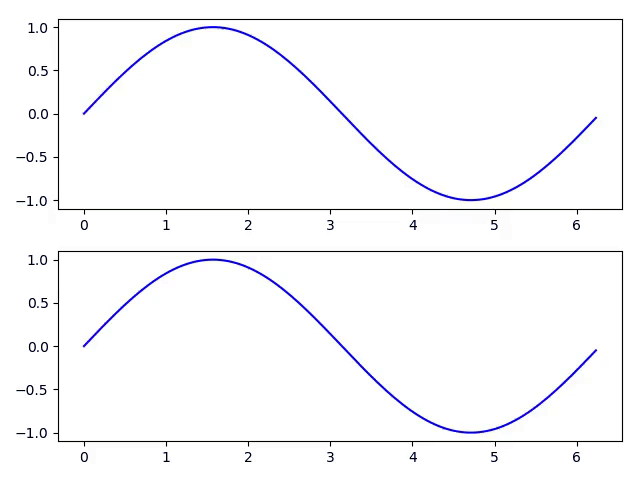https://github.com/jwkvam/celluloid
:movie_camera: Matplotlib animations made easy
https://github.com/jwkvam/celluloid
animation matplotlib matplotlib-animation
Last synced: 5 months ago
JSON representation
:movie_camera: Matplotlib animations made easy
- Host: GitHub
- URL: https://github.com/jwkvam/celluloid
- Owner: jwkvam
- License: mit
- Created: 2018-11-17T02:53:47.000Z (almost 7 years ago)
- Default Branch: master
- Last Pushed: 2024-02-16T17:12:46.000Z (over 1 year ago)
- Last Synced: 2025-04-14T12:10:34.610Z (6 months ago)
- Topics: animation, matplotlib, matplotlib-animation
- Language: Python
- Homepage:
- Size: 35.2 KB
- Stars: 1,132
- Watchers: 11
- Forks: 43
- Open Issues: 20
-
Metadata Files:
- Readme: README.md
- Changelog: History.md
- License: LICENSE
Awesome Lists containing this project
README
# celluloid
[](https://travis-ci.com/jwkvam/celluloid)
[](https://codecov.io/gh/jwkvam/celluloid)
[](https://pypi.org/project/celluloid/)
[](https://pypi.org/project/celluloid/)
Easy Matplotlib Animation
Creating animations should be easy.
This module makes it easy to adapt your existing visualization code to create an animation.
## Install
```
pip install celluloid
```
## Manual
Follow these steps:
1. Create a matplotlib `Figure` and create a `Camera` from it:
```python
from celluloid import Camera
fig = plt.figure()
camera = Camera(fig)
```
2. Reusing the figure and after each frame is created, take a snapshot with the camera.
```python
plt.plot(...)
plt.fancy_stuff()
camera.snap()
```
3. After all frames have been captured, create the animation.
```python
animation = camera.animate()
animation.save('animation.mp4')
```
The entire [module](https://github.com/jwkvam/celluloid/blob/master/celluloid.py) is less than 50 lines of code.
### Viewing in Jupyter Notebooks
View videos in notebooks with [IPython](https://ipython.readthedocs.io/en/stable/api/generated/IPython.display.html#IPython.display.HTML).
```python
from IPython.display import HTML
animation = camera.animate()
HTML(animation.to_html5_video())
```
## Examples
### Minimal
As simple as it gets.
```python
from matplotlib import pyplot as plt
from celluloid import Camera
fig = plt.figure()
camera = Camera(fig)
for i in range(10):
plt.plot([i] * 10)
camera.snap()
animation = camera.animate()
```
### Subplots
Animation at the top.
```python
import numpy as np
from matplotlib import pyplot as plt
from celluloid import Camera
fig, axes = plt.subplots(2)
camera = Camera(fig)
t = np.linspace(0, 2 * np.pi, 128, endpoint=False)
for i in t:
axes[0].plot(t, np.sin(t + i), color='blue')
axes[1].plot(t, np.sin(t - i), color='blue')
camera.snap()
animation = camera.animate()
```
### Images
Domain coloring example.
```python
import numpy as np
from matplotlib import pyplot as plt
from matplotlib.colors import hsv_to_rgb
from celluloid import Camera
fig = plt.figure()
camera = Camera(fig)
for a in np.linspace(0, 2 * np.pi, 30, endpoint=False):
x = np.linspace(-3, 3, 800)
X, Y = np.meshgrid(x, x)
x = X + 1j * Y
y = (x ** 2 - 2.5) * (x - 2.5 * 1j) * (x + 2.5 * 1j) \
* (x - 2 - 1j) ** 2 / ((x - np.exp(1j * a)) ** 2
* (x - np.exp(1j * 2 * a)) ** 2)
H = np.angle(y) / (2 * np.pi) + .5
r = np.log2(1. + np.abs(y))
S = (1. + np.abs(np.sin(2. * np.pi * r))) / 2.
V = (1. + np.abs(np.cos(2. * np.pi * r))) / 2.
rgb = hsv_to_rgb(np.dstack((H, S, V)))
ax.imshow(rgb)
camera.snap()
animation = camera.animate()
```
### Legends
```python
import matplotlib
from matplotlib import pyplot as plt
from celluloid import Camera
fig = plt.figure()
camera = Camera(fig)
for i in range(5):
t = plt.plot(range(i, i + 5))
plt.legend(t, [f'line {i}'])
camera.snap()
animation = camera.animate()
```
## Limitations
- The axes' limits should be the same for all plots. The limits of the animation will be the limits of the final plot.
- Legends will accumulate from previous frames. Pass the artists to the [`legend`](https://matplotlib.org/api/_as_gen/matplotlib.pyplot.legend.html) function to draw them separately.
- [Animating the title does not work](https://stackoverflow.com/questions/47421486/matplotlib-artist-animation-title-or-text-not-changing). As a workaround you can create a text object:
```python
ax.text(0.5, 1.01, 'computed title', transform=ax.transAxes)
```
- This can demand a lot of memory since it uses [`ArtistAnimation`](https://matplotlib.org/api/_as_gen/matplotlib.animation.ArtistAnimation.html) under the hood. This means that all artists are saved to memory before the animation is constructed.
- This is a black box. If you want to understand how matplotlib animations work, using this library may hinder you. If you want to be an expert matplotlib user, you may want to pass on this library.
## Credits
Inspired by [plotnine](https://github.com/has2k1/plotnine/blob/master/plotnine/animation.py).



